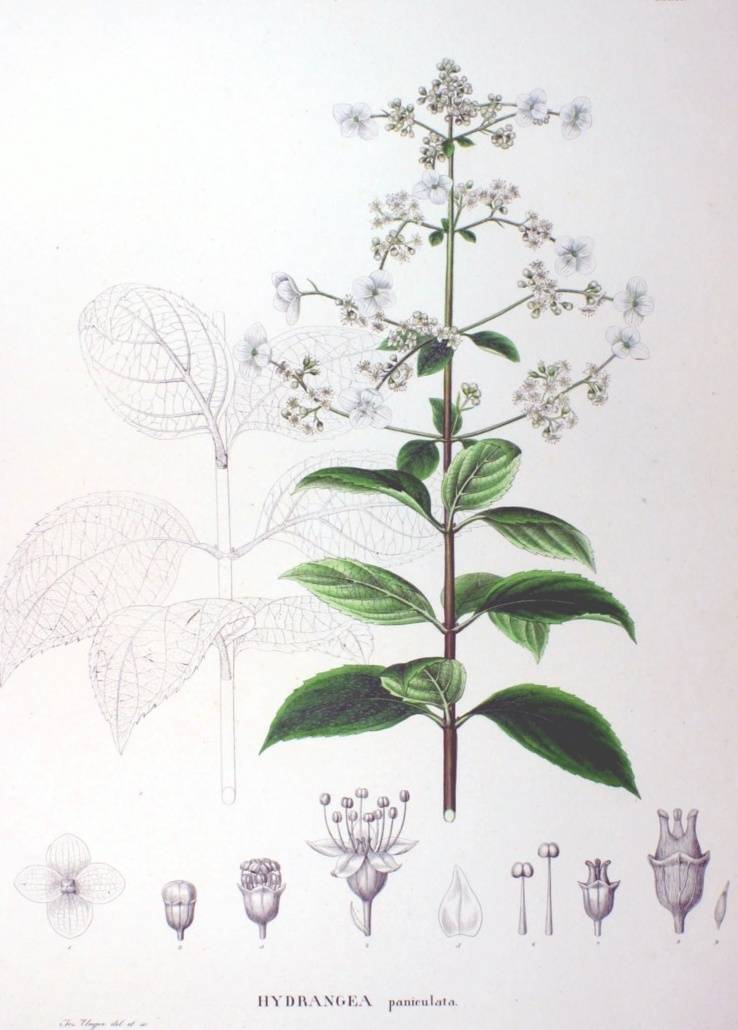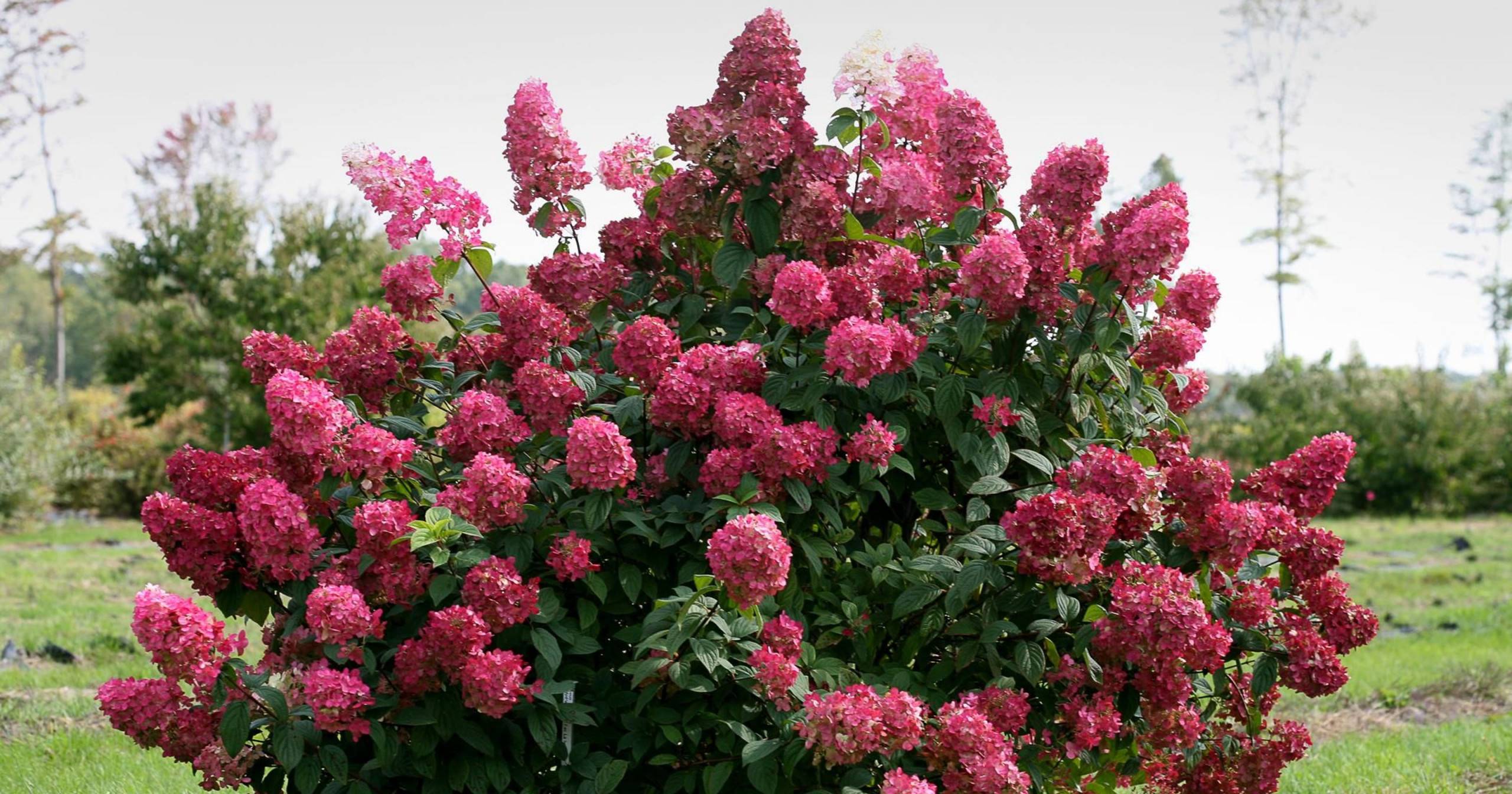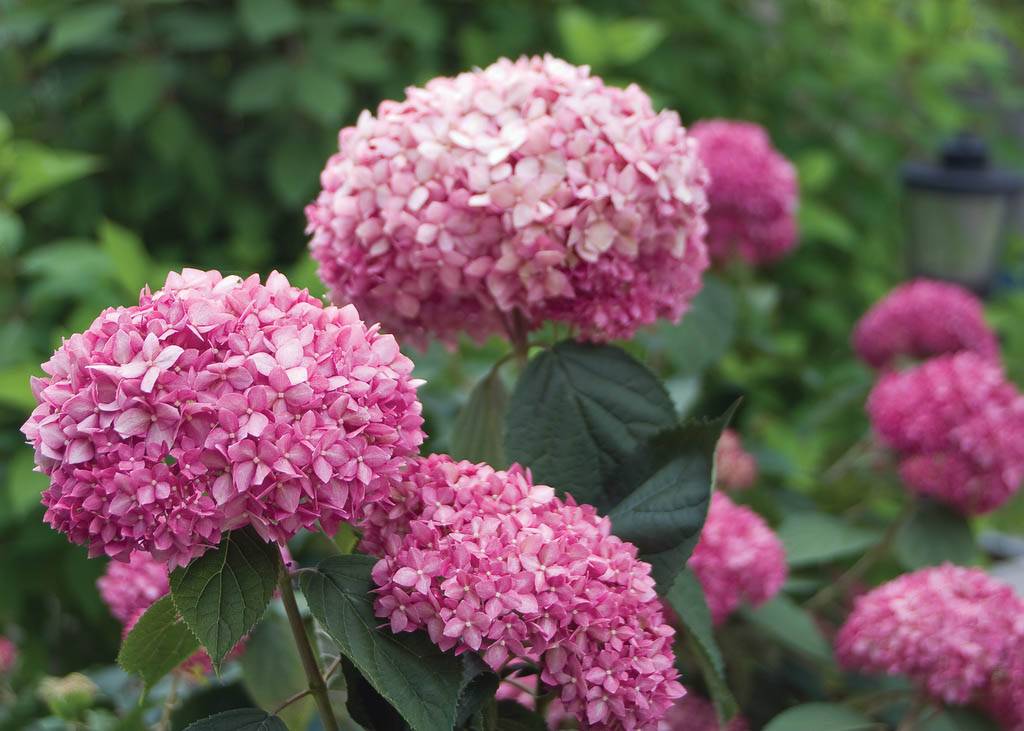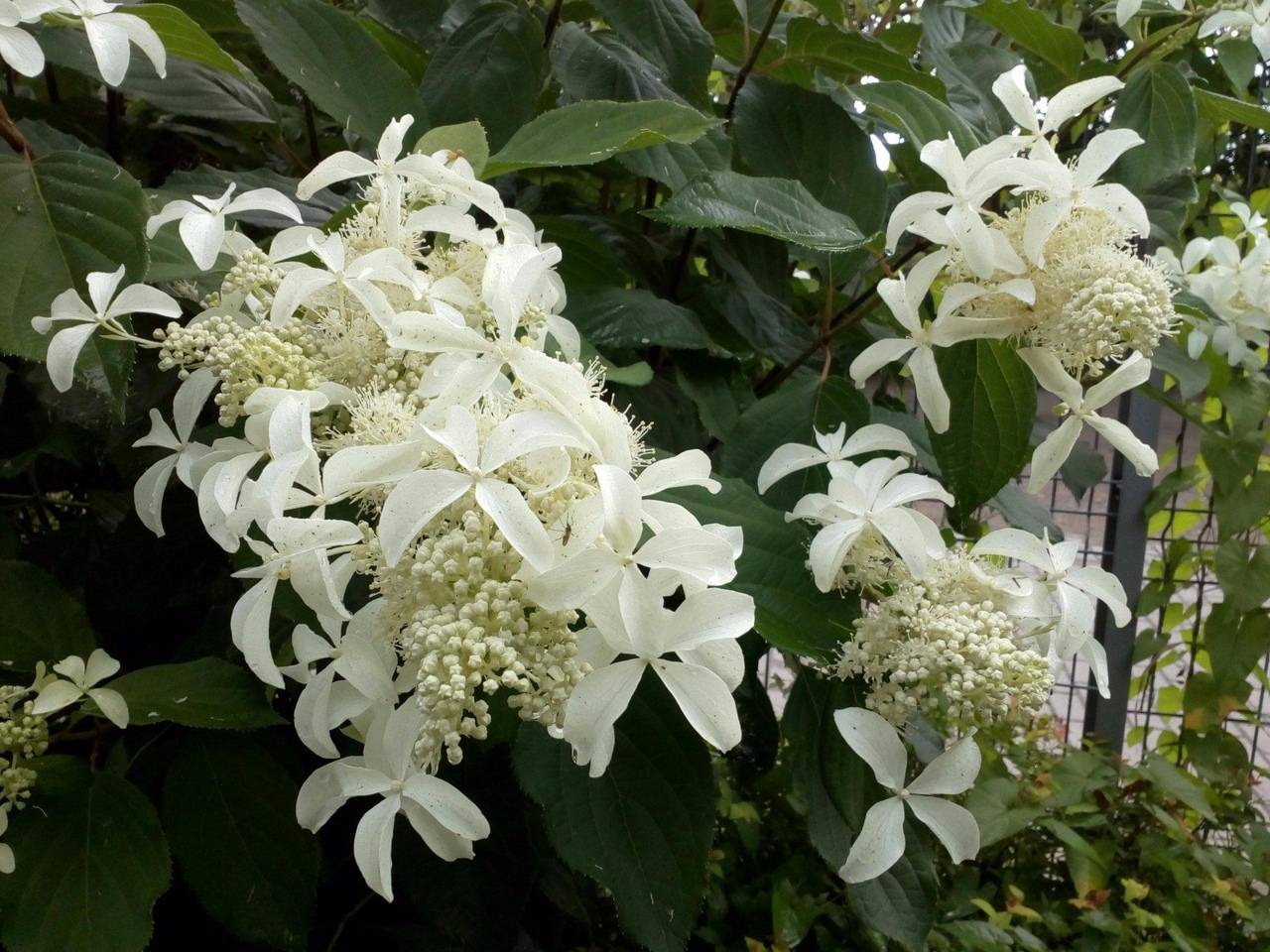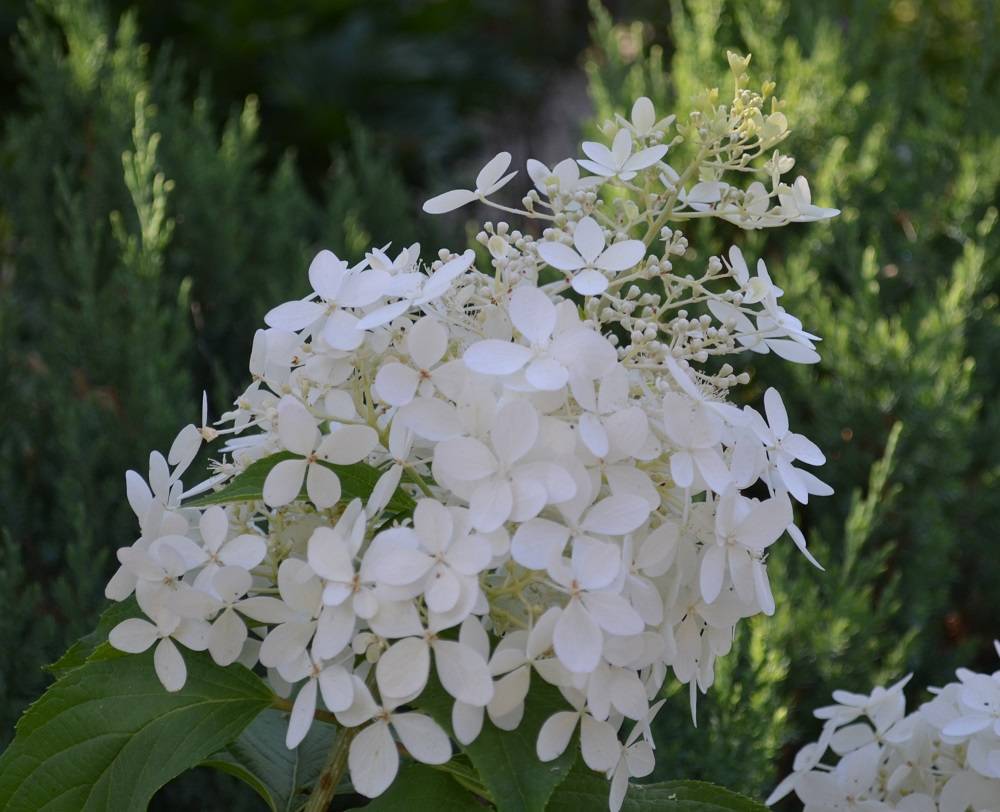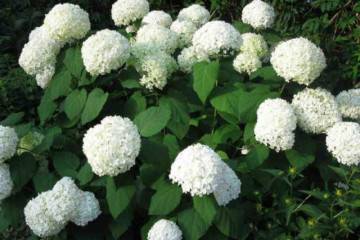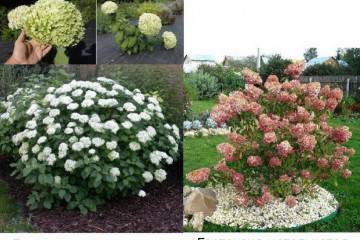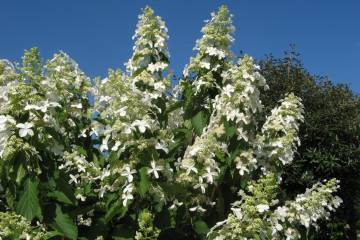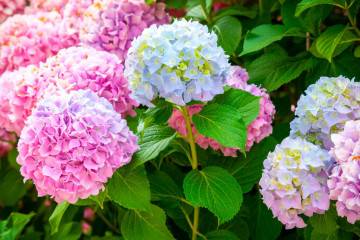Hydrangea paniculata white, red, pink - the best winter-hardy varieties
Content:
The panicle type of hydrangea is often found in the gardens of central Russia, including the Moscow region. It is no coincidence that the choice of landscape designers falls on this plant, it is frost-resistant and very decorative.
The origin and appearance of panicle hydrangeas
The botanical species hydrangea paniculata (Hydrangea Paniculata) belongs to the Hortensia family. In nature, it grows along the edges of oak forests in the south of Sakhalin, in China and Japan.
Appearance features:
- Shrubs and trees up to 10 m high.
- Superficial root system, the diameter of which is much larger than the diameter of the crown.
- The leaf blades are elliptical or ovoid, up to 12 cm long.
- Inflorescence is a wide-pyramidal panicle up to 25 cm long.
- The inflorescence is composed of small, prolific and large, up to 2.5 cm in diameter, sterile flowers.
- The fruit is a capsule up to 3 mm in diameter, small seeds.
- Bloom from mid June to early October.
The most beautiful varieties of panicle hydrangeas
The selection of hydrangeas has been going on for a long time and successfully, many different varieties have been obtained. The most attractive ones are described below.
Red and burgundy hydrangeas
Scarlet hydrangeas are very effective and eye-catching. The most popular varieties are:
- Red Diamond (Daimon Rouge). It blooms with white flowers, by autumn they become bright scarlet. The crown of the bush is spherical.
- Weems Ed. Low-growing variety, no more than 1.5 meters high. Inflorescences are narrow, up to 40 cm long. Light flowers turn wine-red by autumn.
Pink and crimson
Pink hydrangeas are gentle and airy:
- Daruma (Hydrangea Paniculata Dharuma). It grows in height very slowly, reaching 1.5 m. Leaves with a dark red tint. Flowers in inflorescence are asexual, creamy at the beginning of flowering, then turn dark pink.
- Pink Annabel. High shrub. The variety is simple in agricultural technology, winters well. Freshly blossomed flowers are dark pink, then brighten.
White hydrangeas
In landscape design, they often use:
- Grandiflora. An old variety, popular in the Leningrad region. In June, the inflorescences are cream, then become snow-white, by September - crimson.
- Great Star. Tall variety, can be up to 2 meters. Snow-white inflorescences. Corollas of fertile flowers in the shape of a star.
White and pink hydrangeas
Hydrangeas are white-pink paniculate, most commonly found in gardens:
- Freise Melba. The bush is high, while the crown is dense. Tolerates formation well. Corollas at the base of the inflorescence are crimson, the upper flowers are snow-white. The color transition is smooth.
- Strawberry Blossom has a spreading crown and can withstand temperatures as low as -35 degrees. The variety can be grown even in Siberia and the Urals. Blooms for a long time.At the beginning of flowering, corollas are white-green, then turn white at the top, and in the lower third of the inflorescence, deep pink.
Yellow hydrangea
The inflorescences of the Limelight variety are bright yellow in color. A tall bush can grow up to three meters. The flowering period is short: from August to October.
Small panicle hydrangeas
Low-growing hydrangeas are used in curbs. The most popular dwarf varieties:
- Bobo. In height, the bushes of this variety do not exceed 70 cm. Hydrangea is often grown on balconies and terraces. Strong short shoots bear large white inflorescences, becoming light pink by September.
- Little Lime. Corollas are yellow-green, lime-colored. The variety got its name from its color. They fade in the sun, by autumn a pink border appears on the petals. The bush is round, 70-80 cm in diameter.
High varieties of hydrangea paniculata
High varieties are used as hedges and specimen plantings. The high varieties include:
- Pinky Winky grows up to two meters in height. A fast variety that can bloom in the first year after planting. In the inflorescence, the buds are of two shades: at the top, the panicles are white, and at the base, they are purple.
- Phantom. This variety can hibernate without shelter. Differs in large inflorescences up to 40 cm in length. At the beginning of flowering, the petals are light green, with time they turn light pink.
Hydrangeas Sunday Freise and Vanilla Freise
You can compare the varieties in the table.
| Sign | Sunday Fries | Vanilla Fraze |
| Bush height | Up to 2 m | Not more than 1 m |
| Petal color | Initially white, then turning pink | |
| Inflorescence shape | Large heavy panicles | |
| Flowering period | July-September | |
| Foliage | Dark green | Light green |
| Winter hardiness | Needs good shelter for the winter |
Hydrangea paniculata Alex Schumacher
Alex Schumacher is a Dutch company founded in 2002. Her breeders have created a group of unique varieties. These include Diamond Rouge, Kendelite, Little Lime, Summer Love, Summer Snow and many others.
Hydrangea Spocky
Little Spocky is a dwarf variety. The bushes barely grow up to 50 cm high and 30 cm wide. White-green flowers are collected in domed inflorescences. Blooms from mid to late summer. Resistant to cold temperatures down to -25 degrees.
Hydrangea paniculata Mustela
Dark green foliage, inflorescences are loose, lacy, creamy white. It reaches a height of 1.5 to 2 meters. Blooms profusely from August to September.
The difference between hydrangea tree and paniculate
A comparison of the features of paniculate and tree-like hydrangeas is given in the table.
| Sign | Panicle hydrangea | Tree hydrangea |
| Life form | Shrubs or trees up to 10 meters high | Shrub or small tree up to 3 meters high |
| Inflorescence | Panicle | Shield |
| Flowering period | June-October | July-October |
| Frost resistance | High | Low |
Transplanting panicle hydrangeas after purchase in open ground
Hydrangea should be planted in early spring or autumn. In summer, during flowering, this is not recommended. The plant will drop buds and flowers, refuse to bloom for the next season.
The panicle hydrangea should be planted in a sunny place or in partial shade. The soil is preferable fertile, well moistened and drained, with an acidic reaction.
An ideal planting site should meet the following requirements:
- Diffused lighting. Direct sunlight appears only in the morning.
- Quiet, sheltered from the winds.
- Moist soil, but no stagnant processes.
- Acid reaction of the soil (pH 4.5-5).
Step-by-step planting process:
- Prepare a landing pit 50x50x50 cm in size.
- Spill the hole with water a day before planting.
- Place 20 cm of nutrient soil on the bottom of the hole.
- Add 20 g of superphosphate and potassium sulfate.
- Set the bush in the hole, sprinkle with soil mixture on the sides.
- Leave the root collar at ground level.
- Water the plant abundantly.
- Mulch the soil around the trunk with sawdust or hardwood bark.
Reproduction of paniculate hydrangeas
When buying seedlings or seeds, there is a risk of getting the wrong variety that was needed. Self-propagation guarantees the transfer of varietal traits and is a fun process in itself.
Propagation by cuttings
Propagating hydrangea with green cuttings is the easiest and most affordable option. A green stalk is part of a stem with leaves and several buds. Planting material is harvested in mid-July. Cuttings take root well:
- From young plants or from those that have undergone anti-aging pruning.
- Sliced from the side branches in the lower, well-lit part of the bush.
- No signs of diseases or pests.
- Collected early in the morning.
Rooting order:
- After cutting, the shoots are immediately placed in water.
- The top with the bud should be removed from the shoot.
- Divide the rest into sections with 2-3 pairs of leaves.
- Remove the lower leaves from each cutting, cut the upper leaves by a third.
- Place the cuttings in a rooting stimulant solution for 2 hours.
- Dip the cuttings into a moistened mixture of sand and peat (1: 2).
- Cover the cuttings with a jar.
- Water 2-3 times a week.
- The cans can be removed after 25-30 days.
Growing from cuttings
Hydrangea is propagated by layering in early spring.
Description of the order of reproduction by layering:
- Around the bush, you need to loosen and level the soil.
- Dig out radial grooves.
- Place and pin several lower shoots into the grooves.
- By the end of summer, 2-3 babies will grow on each layer.
- Young plants that have reached a size of 15-20 cm are spud to form lateral roots.
- In October, the babies can be separated from the mother plant and buried in until spring.
Dividing the bush
By dividing, the plant is propagated during transplantation. But you should know that garden panicle hydrangea tolerates such a procedure very badly.
Caring for paniculate hydrangeas
Caring for hydrangeas is not difficult, the main thing is to do everything on time. The plant loves moisture, therefore, it is impossible to dry out the soil in the place of its growth. You need to water with slightly acidified water. In the heat, they are watered twice a week. Pour 30-40 liters of water under one bush.
For abundant and long flowering, hydrangea bushes need to be fed at least twice during the growing season. The first top dressing is in early May. Produced before buds appear. Use urea - 1 tsp. per liter of water. Each bush will need 30 liters of solution. The second top dressing is carried out in the fall by applying a complex fertilizer.
Features of care during flowering
During flowering, the plant needs regular, abundant watering. At the very beginning of the opening of the buds, you can feed the bushes with a solution of mullein or chicken droppings (1:10).
Features of care during the rest period
After the plant has bloomed, it is prepared for wintering:
- Withered inflorescences are removed.
- Huddle the base of the bush.
- Mulch the earth.
Even if the winter is predicted to be mild, it is better to play it safe and cover the bushes. This is usually done in October. The branches are tied, pressed to the ground and covered with spunbond or lutrasil. Then a metal mesh is installed around the bush. Fallen leaves are poured into the resulting mesh cylinder.
Planting and caring for paniculate hydrangea in the open field is not a problem, the main thing is to strictly follow the recommendations.
